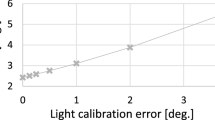Abstract
We present an active vision algorithm for computing the orientation and position of a locally planar object, onto which is cast a shadow of the edge of a half-plane at an unknown location. This algorithm utilises active position control of a point light source, and employs a Kalman filter to perform temporal integration of measurements. The light source position is adjusted after each measurement so as to reduce the trace of the expected state estimate error covariance matrix for the next measurement. We demonstrate the active shape-from-shadows algorithm using a real robotic system.
Similar content being viewed by others
References
Aloimonos, Y., Weiss, I., and Bandyhopadhyay, A. 1988. Active vision. International Journal of Computer Vision, 2:333-356.
Bajcsy, R. 1988. Active perception. In Proceedings of the IEEE, 76 (8):996-1005.
Chaumette, F. and Boukir, S. 1991. Structure from motion using an active vision paradigm. In Proc. 11th Int. Conf. Pattern Recognition, The Hague, Netherlands.
Clark, J.J. 1992. Active photometric stereo. In Proceedings of the 1992 IEEE Computer Vision and Pattern Recognition Conference, Champaign, IL, June, pp. 29-35.
Clark, J.J. and Wang, L. 1997. Trajectories for optimal temporal integration in active vision systems. In Proceedings of the IEEE International Conference and Robotics and Automation, Albuquerque N.M., pp. 431-436.
Clark, J.J. and Yuille, A.L. 1990. Data Fusion for Sensory Information Processing Systems. Kluwer Academic Publishers: Boston, MA.
Durrant-White, H.F. 1988. Integration, Coordination, and Control of Multi-Sensor Robot Systems. Kluwer Academic Publishers: Boston, MA.
Faugeras, O., Ayache, N., and Faverjon, B. 1986. Building visual maps by combining noisy stereo measurements. In Proceedings of the 1986 IEEE International Conference on Robotics and Automation, pp. 1433-1438.
Gelb, A. (Ed.), Applied Optimal Estimation.MIT Press: Cambridge, MA.
Harris, C. 1992. Tracking with rigid models. In Active Vision, A. Blake and A. Yuille, (Eds.). MIT Press: Cambridge, MA.
Kender, J. and Smith, E. 1987. Shape from darkness: Deriving surface information from dynamic shadows. In Proceedings of AAAI, pp. 539-546.
Kirlin, R.L. and Moghaddamjoo. 1986. Robust adaptive Kalman filtering for systems with unknown step inputs and non-Gaussian measurement errors. IEEE Transactions on ASSP, 34(2): 252-263.
Langer, M.S., Dudek, G., and Zucker, S.W. 1995. Space occupancy using shadow images. In Proceedings of International Robotics Symposium (IROS).
Martinez, J.M. and Montano, L. 1993. A camera motion strategy to localize uncertain 3D lines. In Proc. 1993 IEEE Int. Conf. on Systems, Man and Cybernetics, Le Touquet France, pp. 517-522.
Matthies, L.H., Kanade, T., and Szeliski, R. 1989. Kalman filterbased algorithms for estimating depth from image sequences. In International Journal of Computer Vision, 3:209-236.
Meier, L., Peschon, J., and Dressler, R.M. 1967. Optimal control of measurement subsystems. IEEE Transactions on Automatic Control, AC-12(5):528-536.
Oshima, M. and Shirai, Y. 1983. Object recognition using 3-D information. IEEE Transactions on Pattern Analysis and Machine Intelligence, 5(4):353-361.
Raviv, D., Pao, Y., and Loparo, K. 1989. Reconstruction of threedimensional surfaces from two-dimensional binary images. IEEE Transactions on Robotics and Automation, 5(5):701-710.
Shirai, Y. 1972. Recognition of polyhedrons with a range finder. Pattern Recognition, 4:243-250.
Shmuel, A. and Werman, M. 1990. Active vision: 3D from an image sequence. In Proceedings of the 10th International Conference on Pattern Recognition, June, pp. 48-54.
Tarabanis, K.A., Allen, P.K., and Tsai, R.Y. 1995. A survey of sensor planning in computer vision, IEEE Transactions on Robotics and Automation, 11:86-104.
Terzopoulos, D. and Szeliski, R. 1992. Tracking with Kalman snakes. In Active Vision, A. Blake and A. Yuille (Eds.). MIT Press: Cambridge, MA.
Waltz, D. 1983. Understanding line drawings of scenes with shadows. In The Psychology of Computer Vision, P.H. Winston (Ed.). McGraw-Hill, New York, pp. 19-91.
Wang, L. 1995. 3D structure from active shadowing. Ph.D. Thesis, Division of Applied Sciences, Harvard University.
Whaite, P. and Ferrie, F.P. 1994. Autonomous exploration: Driven by uncertainty. In Proceedings of 1994 IEEE Conference on Computer Vision and Pattern Recognition, Seattle WA, June, pp. 339-346.
Wu, W.R. and Kundu, A. 1996. Recursive filtering with non-Gaussian noises. IEEE Transactions on Signal Processing, 44(5): 1454-1469.
Author information
Authors and Affiliations
Rights and permissions
About this article
Cite this article
Clark, J.J., Wang, L. Active Shape-from-Shadows with Controlled Illuminant Trajectories. International Journal of Computer Vision 43, 141–166 (2001). https://doi.org/10.1023/A:1011131412869
Issue Date:
DOI: https://doi.org/10.1023/A:1011131412869




